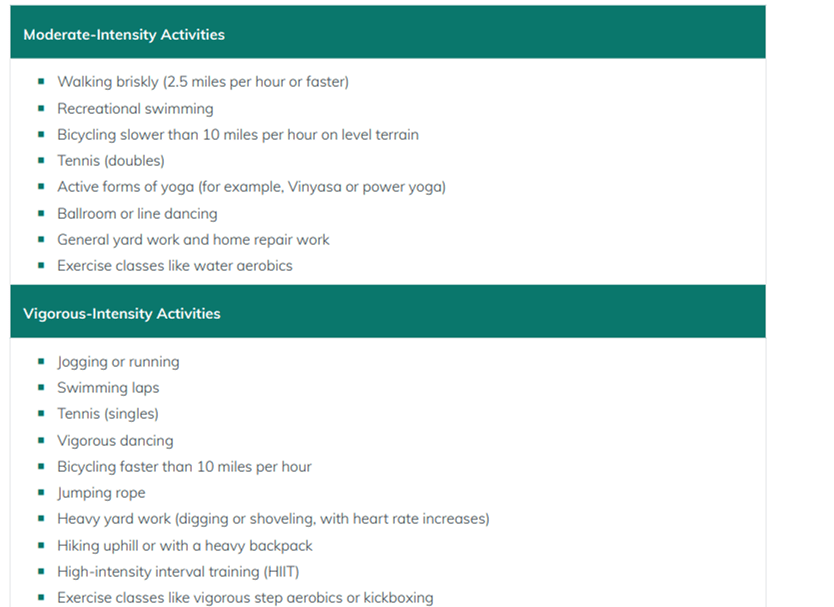Anxiety is associated with sedentary behavior, according to a review of 31 studies (1).
They defined sedentary behavior as low levels of energy expenditure (1.0 to 1.5 of metabolic equivalent of task [MET]), usually occurring while sitting, during work or leisure activities, including screen behaviors (e.g., TV watching), hobbies (e.g., reading books), lying down, in transit, or during driving a car (1,2,3).
What was the study? (1)
The study authors (1) did a systematic review and found k = 31 original studies (total N = 99,192 ) and k = 17 (total N = 27,443) in a meta-analysis.
What were the results? (1)
The authors (1) concluded that higher levels of SB are associated with higher levels of anxiety symptoms.
A separate systematic review found exercise as helpful for anxiety (7).
What is a reasonable amount of activity or how much should I exercise?
The recommended exercise or activity duration according to The Department of Health and Human Services’ “Physical activity guidelines for Americans” (5, 6):
- For moderate intensity activity, 20 to 42 minutes a day (150minutes to 300 minutes per week).
- For vigorous intensity activity, 10 to 21 minutes a day (75 to 150 minutes a week).
What are some examples of moderate and vigorous intensity activities (exercise) ? (6)
What are some precautions?
- It may be best to check with your healthcare provider to make sure it’s safe for you’re to start an exercise program.
- Individuals with a history of disordered eating or disordered exercise should check with their health professional before exercising.
- It may be wise to stop exercise and seek professional help if you notice:
- Increased depression, disordered eating, and other mental health concerns due to exercise.
- Injury, pain, or decreased motivation
- Obsessive behaviors
- Other symptoms.
- Exercise may not help without proper nutrition, so it may be wise to learn about proper nutrition and proper exercise technique, and exercise/nutrition plans, before starting to exercise.
- It may be helpful to gradually start exercising to give yourself time to adjust to an active lifestyle.
- It might take weeks months or longer for some people to get used to and enjoy the minimum activity guidelines.
- Occasional weeks without exercise or light activity may be important to prevent injury.
- Figuring out what works best for you may give you lasting benefits.
By R. Ryan S Patel DO, FAPA OSU-CCS Psychiatrist
Disclaimer: This article is intended to be informative only. It is advised that you check with your own physician/mental health provider before implementing any changes. With this article, the author is not rendering medical advice, nor diagnosing, prescribing, or treating any condition, or injury; and therefore claims no responsibility to any person or entity for any liability, loss, or injury caused directly or indirectly as a result of the use, application, or interpretation of the material presented.
References:
- Stanczykiewicz, B., Banik, A., Knoll, N. et al. Sedentary behaviors and anxiety among children, adolescents and adults: a systematic review and meta-analysis. BMC Public Health 19, 459 (2019). https://doi.org/10.1186/s12889-019-6715-3
- Tremblay MS, Colley RC, Saunders TJ, Healy GN, Owen N. Physiological and health implications of a sedentary lifestyle. Appl Physiol Nutr Metab. 2010;35(6):725–40. https://doi.org/10.1139/h10-079.
- Owen N, Healy GN, Matthews CE, Dunstan DW. Too much sitting: the population health science of sedentary behavior. Exerc Sport Sci Rev. 2010;38(3):105–13. https://doi.org/10.1097/jes.0b013e3181e373a2.
- Pate RR, O’Neill JR, Lobelo F. The evolving definition of “sedentary”. Exerc Sport Sci Rev. 2008;36(4):173–8. https://doi.org/10.1097/jes.0b013e3181e373a2.
- https://www.cdc.gov/physicalactivity/basics/adults/index.htm
- https://health.gov/sites/default/files/2019-09/Physical_Activity_Guidelines_2nd_edition.pdf
- Stonerock, Gregory L. et al. “Exercise as Treatment for Anxiety: Systematic Review and Analysis.” Annals of behavioral medicine : a publication of the Society of Behavioral Medicine 49.4 (2015): 542–556. PMC. Web. 9 May 2018.
